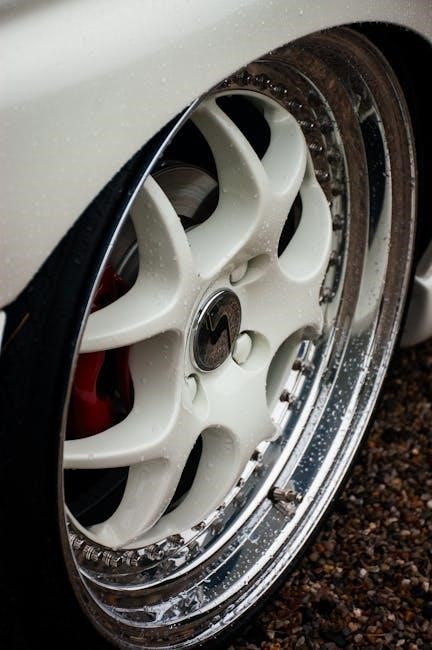Suspension tuning is the process of adjusting suspension components to optimize vehicle performance, stability, and control. Proper tuning enhances handling, ride quality, and overall driving experience, making it a critical aspect of vehicle setup for both on-road and off-road applications.
What is Suspension Tuning?
Suspension tuning involves adjusting suspension components to optimize performance, stability, and control; It focuses on modifying springs, dampers, and other elements to achieve desired handling characteristics. Adjustments include setting sag, pre-load, rebound, and compression damping to suit driving conditions. Proper tuning ensures improved traction, reduced wear, and enhanced ride quality. It requires understanding how components interact and how changes impact vehicle behavior. Tuning can be applied to cars, bikes, or any vehicle with suspension, aiming for a balance between comfort and performance. Regular adjustments ensure optimal setup for varying terrains or driving styles, making it essential for both everyday use and competitive racing.
Why Suspension Tuning is Important
Suspension tuning is crucial for achieving optimal vehicle performance, safety, and comfort. A well-tuned suspension ensures better handling, stability, and responsiveness, which are essential for safe driving. It improves the vehicle’s ability to absorb shocks from uneven surfaces, reducing wear on components and enhancing ride quality. Proper tuning also ensures consistent handling, which builds driver confidence and reduces fatigue. By optimizing the suspension, drivers can achieve better traction, which directly impacts acceleration, braking, and cornering. Whether for everyday driving or competitive racing, suspension tuning plays a vital role in maximizing a vehicle’s potential while maintaining safety and control on the road.

Understanding the Basics of Suspension Systems

Suspension systems are designed to absorb shocks, maintain tire contact, and control vehicle movement. They consist of springs, dampers, and linkages that work together to ensure stability and control.
Key Components of Suspension Systems
The suspension system comprises essential components like springs, dampers, and linkages. Springs absorb impacts and maintain ride height, while dampers control spring oscillations. Linkages connect these parts, ensuring proper geometry. Coilovers, air suspension, and anti-roll bars are common setups. Camber, caster, and toe angles play crucial roles in alignment. These components work together to balance comfort and performance, ensuring stability and control during various driving conditions. Understanding each part’s function is vital for effective tuning and customization.
How Springs and Dampers Work
Springs and dampers are essential components of a suspension system, working together to absorb and control energy from road irregularities. Springs, typically coil or leaf, compress under load, storing energy and releasing it as they rebound, which helps maintain vehicle stability. Dampers, or shock absorbers, regulate the oscillation of springs by converting kinetic energy into heat, preventing excessive bouncing and ensuring a smoother ride. Adjustments like preload and sag optimize the initial compression and weight response, while rebound and compression damping fine-tune how quickly springs react to bumps and weight shifts. Together, they balance comfort and control, adapting to various driving conditions for optimal performance.
The Role of Camber, Caster, and Toe Angles
Camber, caster, and toe angles play a crucial role in suspension tuning, directly influencing a vehicle’s handling and stability. Camber refers to the tilt of the wheels relative to the road, affecting cornering grip and tire wear. Positive camber improves stability at speed, while negative camber enhances lateral grip during turns. Caster, the angle between the steering axis and vertical, impacts self-centering of the wheels and stability at higher speeds. Toe angle, the direction wheels point relative to the vehicle’s centerline, affects straight-line stability and tire longevity. Proper alignment of these angles ensures optimal performance, balancing comfort and responsiveness for specific driving conditions.
Initial Setup and Pre-Load Adjustment
Initial setup involves assessing the vehicle’s weight distribution and intended use to set pre-load, ensuring proper sag for optimal suspension performance and ride quality.
Setting Sag and Pre-Load on Coil Shocks
Setting sag and pre-load on coil shocks is the first step in suspension tuning. Sag refers to how much the suspension compresses under the vehicle’s weight. Proper sag ensures optimal travel and handling. To set sag, measure the suspension’s unloaded length, then compress it with the vehicle’s weight and measure again. The difference is the sag. Pre-load adjustment involves tightening or loosening the coil to achieve the desired sag. Use a shock pump for precise adjustments. Aim for 20-30% sag for most applications. Record settings and test the feel of the suspension, adjusting as needed for balance and performance.
Adjusting Ride Height for Optimal Performance

Adjusting ride height is crucial for balancing handling and aesthetics. Ride height affects weight distribution, aerodynamics, and suspension travel. Lowering the vehicle improves cornering grip and reduces roll, while raising it enhances ground clearance. Use coilovers or spacers to adjust height. Measure from the fender to the wheel hub for accuracy. Ensure changes don’t compromise suspension travel or damage components. Test on various surfaces to confirm stability. Proper ride height enhances overall performance and driver confidence, making it a key step in suspension tuning. Always refer to manufacturer guidelines and consider professional assistance for precise adjustments tailored to your vehicle’s specifications and intended use.
Advanced Suspension Tuning Techniques
Advanced techniques involve fine-tuning damping settings, such as rebound and compression, to optimize handling and stability. These adjustments enhance performance and driver feel under various conditions.
Tuning Rebound and Compression Damping

Rebound damping controls how quickly the suspension returns to its neutral position after compression, while compression damping manages how it compresses under load. Adjusting these settings ensures optimal handling and stability. Rebound adjustments are typically made using a shock pump, with higher settings reducing bounce and lower settings improving traction. Compression damping, including low-speed compression, fine-tunes how the suspension reacts to weight transfer and cornering forces. Proper tuning enhances grip, reduces body roll, and improves overall vehicle balance. Trial and error, along with track or trail testing, are essential for finding the perfect balance. These adjustments are critical for achieving precise control and confidence-inspiring performance.
Adjusting Low Speed Compression and Other Settings
Low-speed compression damping affects how the suspension responds to gradual movements, such as weight shifts during cornering. Adjusting this setting can improve stability and reduce unwanted chassis motions. Turning the adjustment clockwise typically increases stiffness, minimizing body roll, while counter-clockwise reduces stiffness, enhancing comfort. Other settings, like high-speed compression, influence handling during rapid impacts, such as bumps. Fine-tuning these parameters ensures the suspension adapts to various driving conditions, optimizing both performance and comfort. Regular testing and data analysis are crucial to refine these adjustments, as subtle changes can significantly impact overall vehicle behavior and driver confidence. Patience and precision are key to achieving the ideal setup.

Testing and Iteration
Testing involves evaluating handling characteristics on various surfaces to identify improvements. Iteration requires adjusting settings, analyzing feedback, and refining until optimal performance is achieved consistently.

Evaluating Handling Characteristics
Evaluating handling characteristics involves assessing how the vehicle behaves during various driving scenarios, such as cornering, braking, and acceleration. Pay attention to traits like pitch, roll, and stability. Testing on different surfaces and speeds helps identify understeer, oversteer, or uneven weight distribution. A well-tuned suspension should maintain consistent tire contact, providing predictable and responsive handling. Note how the vehicle reacts to inputs, ensuring it feels balanced and composed. This evaluation guides further adjustments to achieve optimal performance and driver confidence.
Using Data and Feedback for Further Adjustments
Using data and feedback is crucial for refining suspension tuning. Tools like Motion Instruments can provide detailed insights into how the suspension performs under various conditions. Analyze data to identify patterns, such as excessive compression or rebound, which may indicate improper damping settings. Rider or driver feedback is equally valuable, as it highlights how the vehicle feels during real-world use. Use this information to make targeted adjustments, such as tweaking low-speed compression or adjusting spring rates. Testing and iterating based on data and feedback ensures a more precise and balanced suspension setup, ultimately enhancing performance and ride quality.
Suspension tuning is a methodical process that enhances performance, stability, and control. By adjusting components like sag, damping, and alignment, riders can achieve their ideal setup through careful testing and iteration.
Final Tips for Achieving the Perfect Suspension Setup
For a flawless suspension setup, start by prioritizing weight reduction, brakes, and roll bars. Ensure proper sag and pre-load adjustments are made first, as these are foundational. Always consider tire type and alignment, as they significantly impact handling. Track testing is crucial to determine optimal spring rates and damping settings. Keep a notebook to document changes and their effects. Use data and feedback to refine your adjustments. Remember, small tweaks can make a big difference. Lastly, don’t overlook the importance of ride height and camber adjustments for maximizing grip and stability in corners. Consistency and patience are key to achieving the perfect setup.

